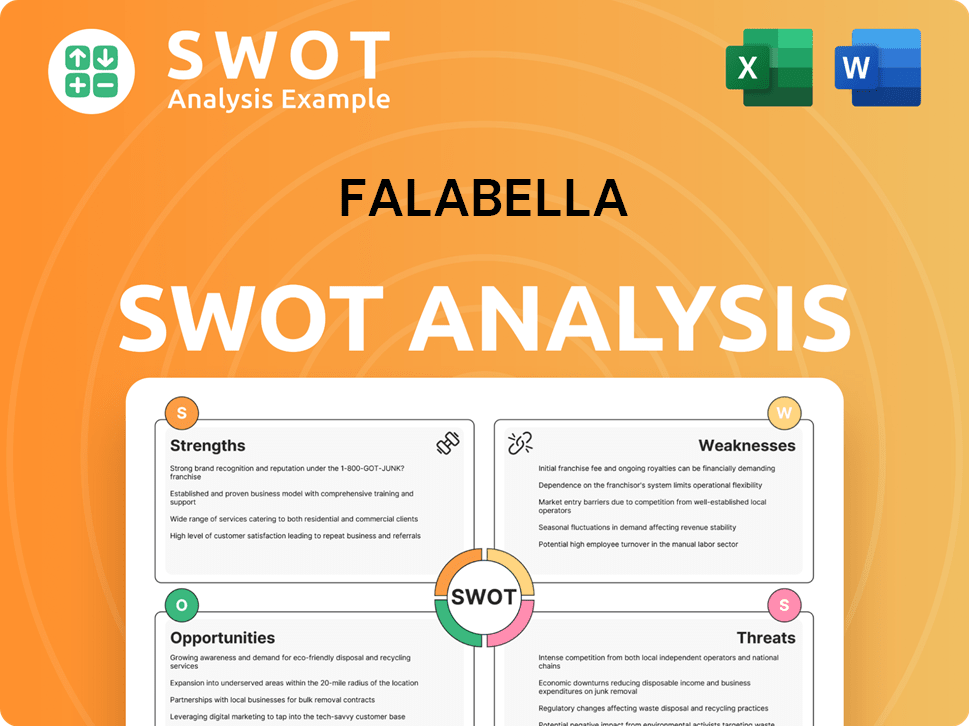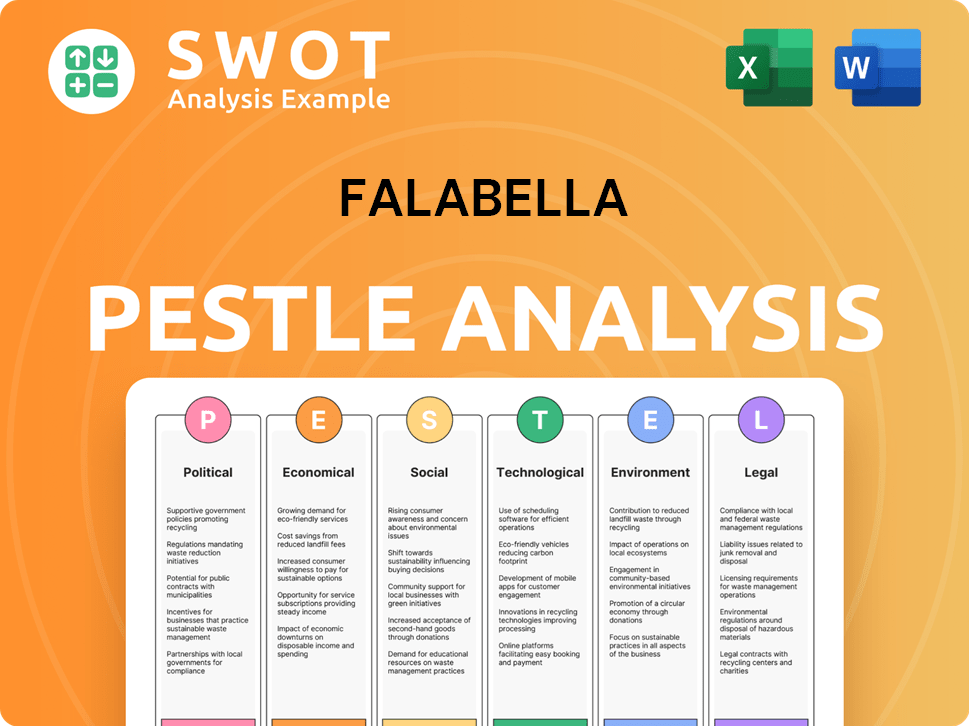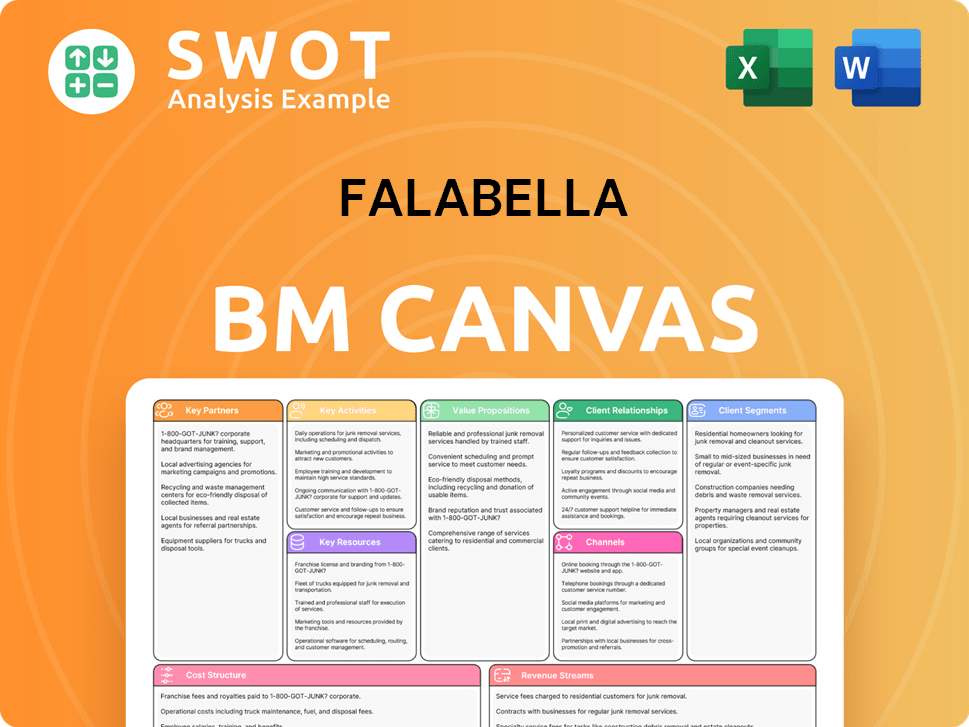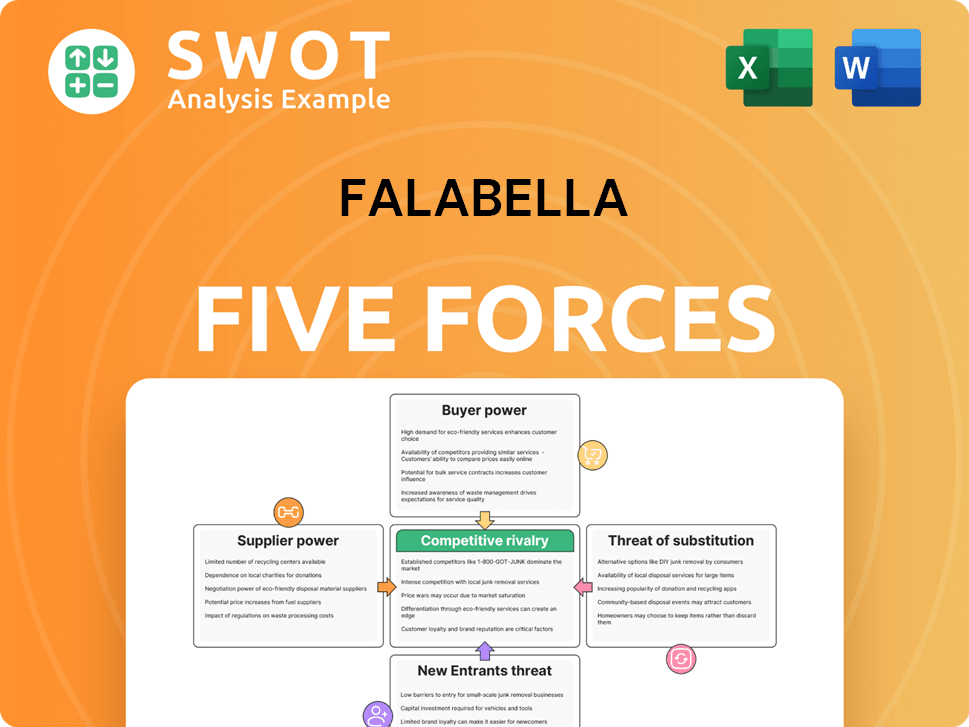Falabella Bundle
Can Falabella Maintain its Retail Dominance?
Falabella, a retail giant with roots in 1889 Chile, has evolved from a tailor shop into a Latin American powerhouse. Its strategic moves, including the integration of financial services, have reshaped the retail landscape. Understanding the Falabella SWOT Analysis is crucial to grasping its trajectory.

This deep dive into the Falabella company analysis examines its growth strategy and future prospects, considering its expansion plans and digital transformation strategy. We'll explore how Falabella aims to leverage innovation and technology to enhance its financial performance and maintain its competitive advantages in the retail industry. The analysis will also touch upon Falabella's recent financial results and its impact on the economy, offering insights into its market share and strategic partnerships.
How Is Falabella Expanding Its Reach?
The company's expansion strategy is multifaceted, focusing on geographical growth and product diversification. This approach aims to capture new customer segments and boost revenue streams. A key element of the strategy involves strengthening its omnichannel presence, integrating online and offline channels to provide a seamless customer experience.
Falabella is actively assessing opportunities within Latin America, seeking to deepen its presence in current markets and explore new territories. This includes integrating its various business units, such as department stores, home improvement, and supermarkets, to create synergistic growth opportunities. For instance, leveraging its store network for online order fulfillment and returns.
The company is also exploring new business models and strategic partnerships to diversify its offerings. This includes expanding its financial services arm, Banco Falabella, by introducing new credit products and digital banking solutions to cater to a broader customer base. These initiatives are designed to stay ahead of evolving consumer preferences and competitive pressures in the dynamic retail landscape.
Falabella is investing heavily in its omnichannel strategy to provide a seamless shopping experience. This includes optimizing e-commerce platforms and integrating them with physical stores. The goal is to offer services like click-and-collect and efficient last-mile delivery, enhancing customer convenience and satisfaction. This approach is crucial for maintaining a competitive edge in the evolving retail landscape.
The company continues to focus on expanding its footprint in Latin America. This involves deepening its presence in existing markets such as Chile, Peru, Colombia, and Argentina. Furthermore, Falabella is exploring potential new territories to broaden its reach. This strategic expansion is a key component of its long-term growth plan.
Falabella is strategically integrating its various business units to create synergistic growth opportunities. This includes leveraging the extensive store network for online order fulfillment and returns. By combining department stores, home improvement stores, and supermarkets, the company aims to enhance operational efficiency and customer experience. This integration is a key element of the Falabella growth strategy.
Banco Falabella is expanding its financial services offerings to cater to a broader customer base. This involves introducing new credit products and digital banking solutions. The expansion of financial services is a strategic move to diversify revenue streams and enhance customer loyalty. This is a key aspect of the Falabella business model.
Falabella is actively exploring new business models and strategic partnerships. This includes expanding its marketplace capabilities, allowing third-party sellers to offer their products through Falabella's digital platforms. This strategy helps expand the product assortment without significant capital expenditure. These initiatives are designed to stay ahead of evolving consumer preferences and competitive pressures.
- Falabella's e-commerce strategy involves continuous investment in its digital platforms.
- The company is focusing on improving its supply chain management to enhance efficiency.
- Strategic partnerships are being formed to expand product offerings and market reach.
- Digital transformation is a key focus area to improve customer experience and operational efficiency.
Falabella SWOT Analysis
- Complete SWOT Breakdown
- Fully Customizable
- Editable in Excel & Word
- Professional Formatting
- Investor-Ready Format

How Does Falabella Invest in Innovation?
The company is significantly investing in technology and innovation to foster sustained growth and strengthen its competitive position. This strategic focus centers on a comprehensive digital transformation across all business units. The aim is to enhance operational efficiency, personalize customer experiences, and unlock new revenue streams. These efforts are crucial for maintaining and improving the company's market share.
A key aspect of this strategy is prioritizing investments in e-commerce platforms, mobile applications, and digital payment solutions. This is designed to cater to the growing digital consumer base in Latin America. The company's approach reflects a deep understanding of evolving consumer preferences and the need to adapt to digital trends. The Falabella growth strategy is heavily reliant on these digital initiatives.
The company's innovation strategy also includes leveraging cutting-edge technologies like artificial intelligence (AI) and data analytics. AI is being used for various applications, including personalized product recommendations, optimizing supply chain logistics, and enhancing customer service through chatbots and virtual assistants. This data-driven approach allows for deeper insights into consumer behavior and market trends, enabling more informed decision-making. This is a key component of its Falabella business model.
Investments in e-commerce platforms and mobile applications are central to the company's digital transformation. These platforms are designed to provide seamless shopping experiences. This is crucial to compete effectively in the retail industry outlook.
The company is utilizing AI for personalized product recommendations and optimizing supply chain logistics. Data analytics provide insights into consumer behavior, enabling more informed decision-making. This enhances Falabella's competitive advantages.
Automation is being explored in warehouses and distribution centers to improve efficiency and reduce operational costs. This focus on efficiency is vital for Falabella's future growth opportunities.
The financial arm, Banco Falabella, is developing new digital products and services, such as innovative credit solutions and digital wallets. This expansion of fintech offerings is a key part of their strategy. This initiative is a key aspect of the Falabella company analysis.
The company focuses on optimizing its supply chain to improve efficiency and reduce costs. Effective supply chain management is crucial for maintaining profitability. This is a key element of Falabella's supply chain management.
Personalizing customer experiences through digital channels is a priority. This includes tailored product recommendations and enhanced customer service. This initiative enhances Falabella's customer loyalty programs.
Furthermore, the company is exploring automation in its warehouses and distribution centers to improve efficiency and reduce operational costs. They are also focused on developing new digital products and services within their financial arm, Banco Falabella, such as innovative credit solutions and digital wallets, to expand their fintech offerings. While specific patents or industry awards for recent breakthroughs are not widely publicized, the company's continuous investment in technology and its commitment to digital transformation underscore its leadership in adopting innovative solutions to achieve its growth objectives in the evolving retail and financial services landscape. For more insights, you can read about the company's performance in this detailed analysis of the retail giant's operations.
The company's focus on technology is evident in its investments in e-commerce, AI, and automation. These initiatives are designed to enhance customer experiences and improve operational efficiency. These efforts are critical to understanding Falabella's market share.
- E-commerce Platforms: Upgrading and expanding online shopping experiences.
- AI Integration: Using AI for personalized recommendations and supply chain optimization.
- Automation: Implementing automation in warehouses and distribution centers.
- Fintech Expansion: Developing innovative financial products and services.
Falabella PESTLE Analysis
- Covers All 6 PESTLE Categories
- No Research Needed – Save Hours of Work
- Built by Experts, Trusted by Consultants
- Instant Download, Ready to Use
- 100% Editable, Fully Customizable

What Is Falabella’s Growth Forecast?
The financial outlook for Falabella reflects a strategic emphasis on enhancing profitability and ensuring a robust balance sheet amidst the evolving retail landscape. For the fiscal year 2024, the company showcased a net income of Ch$ 60,637 million, a significant improvement from the previous year's losses. This positive shift was largely driven by improved margins within its retail operations and a strong performance in its financial services segment. The company also saw a 4.9% increase in adjusted EBITDA for 2024, reaching Ch$ 901,847 million, indicating a solid financial performance.
Falabella's commitment to financial discipline is evident in its efforts to deleverage its balance sheet. As of December 2024, the net financial debt to adjusted EBITDA ratio stood at 3.8x, a reduction from 4.7x in December 2023. This strategic focus aims to bolster the company's financial position and provide flexibility for future investments. These efforts are essential for supporting the Owners & Shareholders of Falabella and ensuring sustainable growth.
Looking ahead, Falabella plans to invest approximately US$ 400 million in capital expenditures for 2025. These investments will primarily focus on strengthening its logistics network, enhancing its technological capabilities, and improving its stores. These initiatives are crucial for supporting the company's growth strategy and improving its market share. While specific revenue targets and long-term profit margin projections are subject to market conditions and company guidance, recent financial results suggest a positive trajectory.
Falabella's recent financial performance highlights a turnaround, with net income improving significantly in 2024. The increase in adjusted EBITDA to Ch$ 901,847 million demonstrates the company's operational efficiency and strategic financial management. These results are crucial for assessing the company's current standing and future prospects.
The reduction in the net financial debt to adjusted EBITDA ratio to 3.8x as of December 2024 showcases Falabella's commitment to deleveraging. This financial discipline strengthens the company's position and provides flexibility for future investments. Such measures are vital for long-term sustainability.
Falabella plans to invest around US$ 400 million in 2025, primarily focusing on logistics, technology, and store improvements. These investments are designed to enhance operational efficiency and customer experience. These strategic investments are key to the company's future growth opportunities.
The company's strategic initiatives in digital transformation and operational efficiency are expected to drive continued recovery and growth. These initiatives are designed to improve the company's competitive advantages and market share. This approach is critical for adapting to the changing retail industry outlook.
Falabella's financial narrative emphasizes sustainable growth, driven by a balanced approach to investment and financial prudence. This approach supports long-term value creation for stakeholders. This balanced strategy is key to the company's impact on the economy.
Analyst forecasts generally anticipate continued recovery and growth, supported by Falabella's strategic initiatives. The company’s performance is subject to market conditions, but its recent results indicate a positive trajectory. Understanding these factors is crucial for assessing the company's future growth opportunities.
Falabella Business Model Canvas
- Complete 9-Block Business Model Canvas
- Effortlessly Communicate Your Business Strategy
- Investor-Ready BMC Format
- 100% Editable and Customizable
- Clear and Structured Layout

What Risks Could Slow Falabella’s Growth?
The growth strategy of Falabella faces several potential risks and obstacles, particularly in the dynamic retail and financial services sectors across Latin America. These challenges include intense competition, regulatory changes, supply chain vulnerabilities, and the rapid pace of technological disruption. Understanding these risks is crucial for evaluating the company's future prospects and overall financial performance.
Intense competition from both traditional and online retailers, such as Mercado Libre and Amazon, puts pressure on Falabella's market share and pricing strategies. Regulatory changes, including consumer protection and data privacy laws, also pose a challenge, demanding continuous adaptation and compliance. Moreover, supply chain disruptions and technological advancements require ongoing investment and strategic agility.
Internal resource constraints, such as the availability of skilled talent in technology and e-commerce, could also hinder innovation and digital transformation. Falabella's management addresses these risks through comprehensive risk management frameworks, including scenario planning and diversification of its business segments. The company's ability to adapt to shifting consumer behaviors and economic volatilities is key to its long-term success.
The retail sector in Latin America is highly competitive, with both established brick-and-mortar stores and rapidly growing e-commerce platforms vying for market share. Companies like Mercado Libre and Amazon are aggressively expanding their presence, which directly impacts Falabella's market share and pricing strategies. This competitive landscape necessitates continuous innovation and strategic adjustments.
Falabella operates across multiple Latin American countries, each with its own set of regulations. Changes in consumer protection laws, data privacy regulations, and financial services regulations can significantly impact operational costs and business models. Adapting to these evolving regulations requires continuous monitoring, compliance efforts, and potentially, significant investments.
Global events, such as geopolitical tensions and natural disasters, can disrupt supply chains, impacting inventory flow, increasing logistics costs, and affecting product availability. These vulnerabilities require robust supply chain management strategies, including diversification of suppliers and proactive risk mitigation plans. The ability to manage these disruptions is critical for maintaining operational efficiency.
Rapid advancements in retail technology, including AI, automation, and new payment systems, demand continuous investment and adaptation. Falabella must invest in these technologies to avoid obsolescence and maintain a competitive edge. This includes significant investments in digital transformation, e-commerce platforms, and data analytics capabilities to enhance customer experience and operational efficiency.
The availability of skilled talent in technology and e-commerce can hinder the pace of innovation and digital transformation. Falabella must attract and retain top talent to drive its digital initiatives. This might involve competitive compensation packages, training programs, and strategic partnerships to ensure access to the necessary expertise. Addressing these constraints is crucial for long-term growth.
Economic fluctuations in Latin America can significantly impact consumer spending and financial performance. Falabella's ability to navigate economic downturns and adapt to changing consumer behaviors is crucial. This includes diversifying its business segments and implementing flexible pricing strategies to maintain profitability. The company's resilience in the face of economic volatility is key to its sustainability.
Falabella employs several strategies to mitigate these risks. These include comprehensive risk management frameworks, scenario planning, and diversification across retail, home improvement, supermarkets, and financial services. The company's focus on digital transformation, as seen during the COVID-19 pandemic, demonstrates its ability to adapt to shifting consumer behaviors and economic conditions. For more insights, see Marketing Strategy of Falabella.
Recent financial results provide insights into Falabella's ability to navigate these challenges. Analyzing the company's revenue, profitability, and market share trends reveals its resilience and adaptability. Reviewing its investments in technology, e-commerce, and supply chain improvements offers a view of its strategic priorities. Understanding the financial performance is key to assessing the company's future prospects.
Falabella Porter's Five Forces Analysis
- Covers All 5 Competitive Forces in Detail
- Structured for Consultants, Students, and Founders
- 100% Editable in Microsoft Word & Excel
- Instant Digital Download – Use Immediately
- Compatible with Mac & PC – Fully Unlocked

Related Blogs
- What are Mission Vision & Core Values of Falabella Company?
- What is Competitive Landscape of Falabella Company?
- How Does Falabella Company Work?
- What is Sales and Marketing Strategy of Falabella Company?
- What is Brief History of Falabella Company?
- Who Owns Falabella Company?
- What is Customer Demographics and Target Market of Falabella Company?
Disclaimer
All information, articles, and product details provided on this website are for general informational and educational purposes only. We do not claim any ownership over, nor do we intend to infringe upon, any trademarks, copyrights, logos, brand names, or other intellectual property mentioned or depicted on this site. Such intellectual property remains the property of its respective owners, and any references here are made solely for identification or informational purposes, without implying any affiliation, endorsement, or partnership.
We make no representations or warranties, express or implied, regarding the accuracy, completeness, or suitability of any content or products presented. Nothing on this website should be construed as legal, tax, investment, financial, medical, or other professional advice. In addition, no part of this site—including articles or product references—constitutes a solicitation, recommendation, endorsement, advertisement, or offer to buy or sell any securities, franchises, or other financial instruments, particularly in jurisdictions where such activity would be unlawful.
All content is of a general nature and may not address the specific circumstances of any individual or entity. It is not a substitute for professional advice or services. Any actions you take based on the information provided here are strictly at your own risk. You accept full responsibility for any decisions or outcomes arising from your use of this website and agree to release us from any liability in connection with your use of, or reliance upon, the content or products found herein.